1994 CHEVROLET BLAZER mirror
[x] Cancel search: mirrorPage 56 of 348
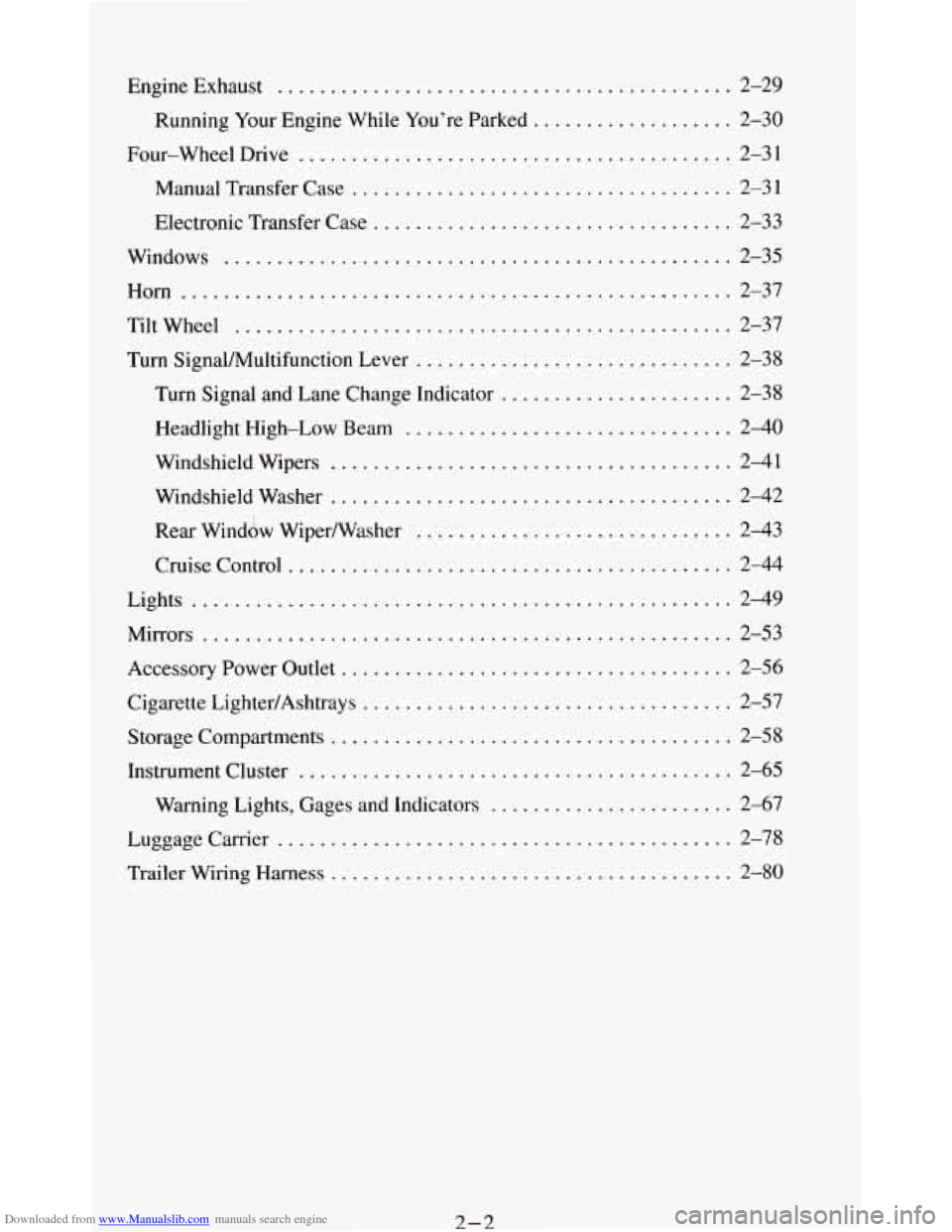
Downloaded from www.Manualslib.com manuals search engine EngineExhaust ........................................... 2-29
Running Your Engine While You’re Parked
................... 2-30
Four-WheelDrive
......................................... 2-31
Manual Transfer Case
.................................... 2-31
Electronic Transfer Case
.................................. 2-33
Windows
................................................ 2-35
Horn
.................................................... 2-37
Tiltwheel
............................................... 2-37
Turn Signal/Multifunction Lever
.............................. 2-38
Turn Signal and Lane Change Indicator
...................... 2-38
Headlight High-Low Beam
............................... 2-40
Windshield Wipers
...................................... 2-41
Windshield Washer
...................................... 2-42
Rear Window Wiper/Washer
.............................. 2-43
Cruise Control
.......................................... 2-44
Lights
................................................. 2-49
Mirrors
.................................................. 2-53
Accessory Power Outlet
..................................... 2-56
Cigarette LightedAshtrays
................................... 2-57
Storage Compartments
...................................... 2-58
Instrument Cluster ......................................... 2-65
Warning Lights. Gages
and Indicators ....................... 2-67
Luggagecarrier
........................................... 2-78
Trailer Wiring Harness
...................................... 2-80
2-2
Page 107 of 348
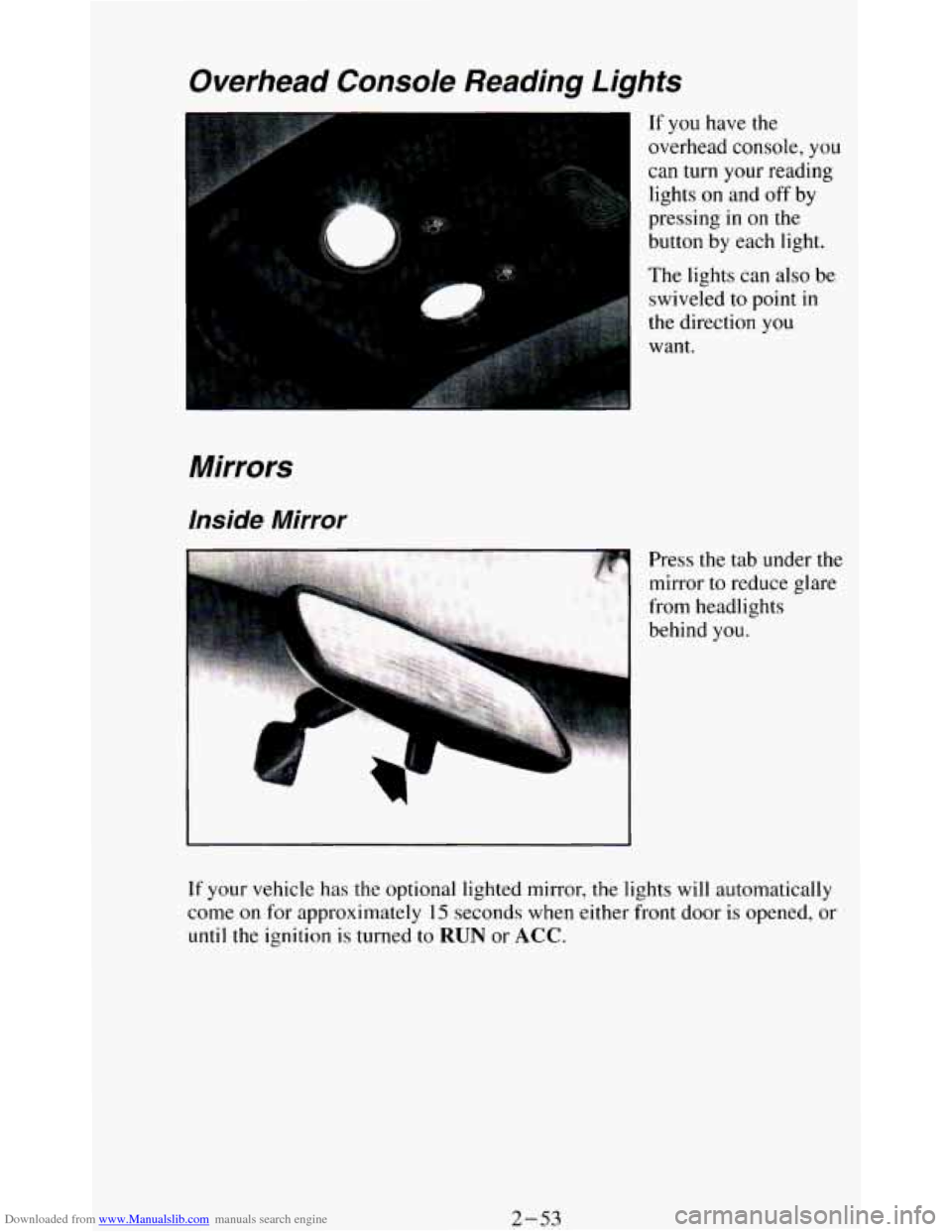
Downloaded from www.Manualslib.com manuals search engine Overhead Console Reading Lights
Mirrors
Inside Mirror
r
If you have the
overhead console, you
can turn your reading
lights
on and off by
pressing
in on the
button by each light.
The lights can also be
swiveled to point
in
the direction you
want.
Press
the tab under the
mirror
to reduce glare
from headlights
behind
you.
If your vehicle has the optional lighted mirror, the lights will automatically
come
on for approximately 15 seconds when either front door is opened, or
until the ignition is turned to RUN or ACC.
2-53
Page 108 of 348
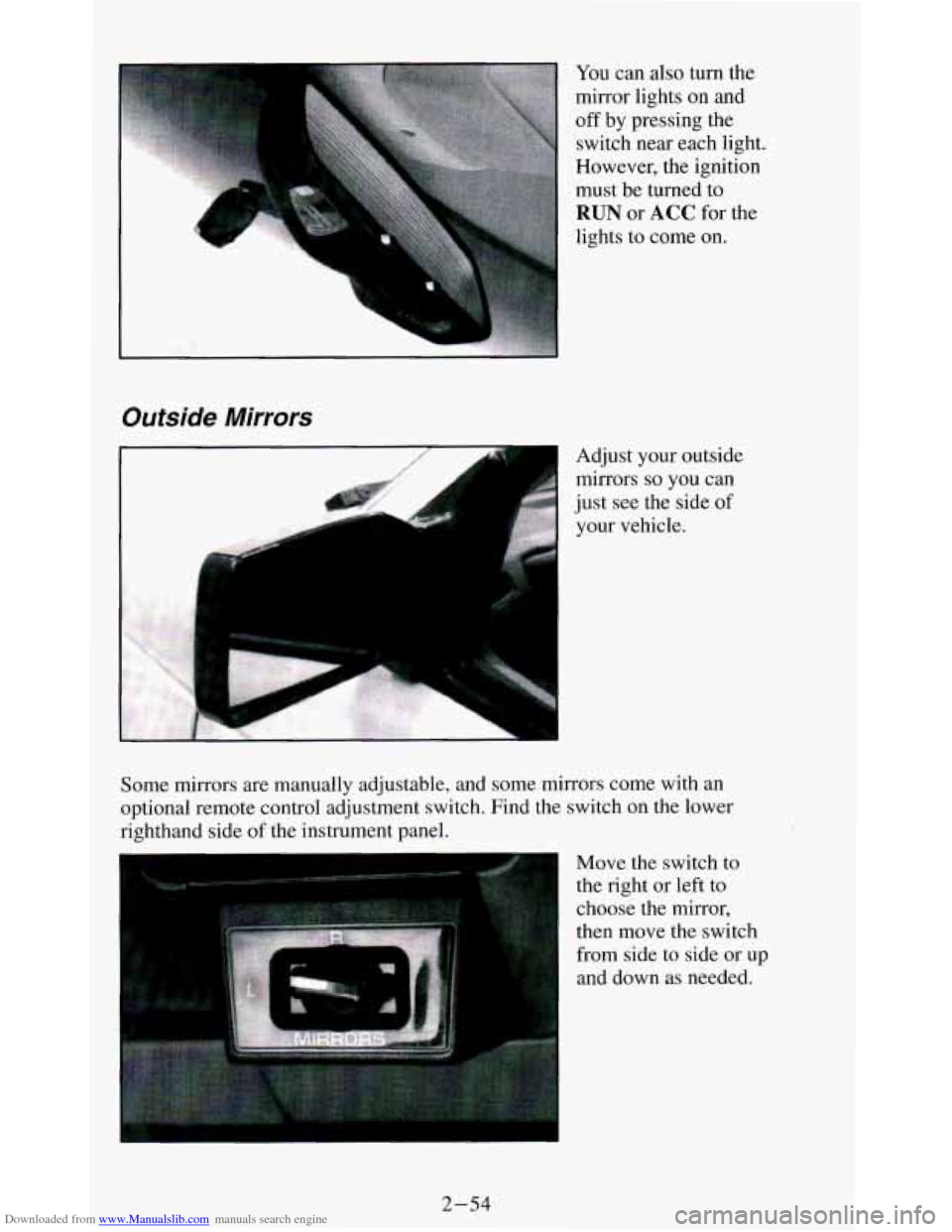
Downloaded from www.Manualslib.com manuals search engine You can also turn the
mirror lights on and
off by pressing the
switch near each light.
However, the ignition
must be turned
to
RUN or ACC for the
lights to come
on.
Outside Mirrors
.,. .,,.. . Adjust your outside
mirrors
so you can
just see the side of
your vehicle.
L J
Some mirrors are manually adjustable, and some mirrors come with an
optional remote control adjustment switch. Find the switch on
the lower
righthand side
of the instrument panel.
Move the switch
to
the right or left to
choose the mirror,
then move the switch
from side to side or up
and down as needed.
2-54
Page 109 of 348
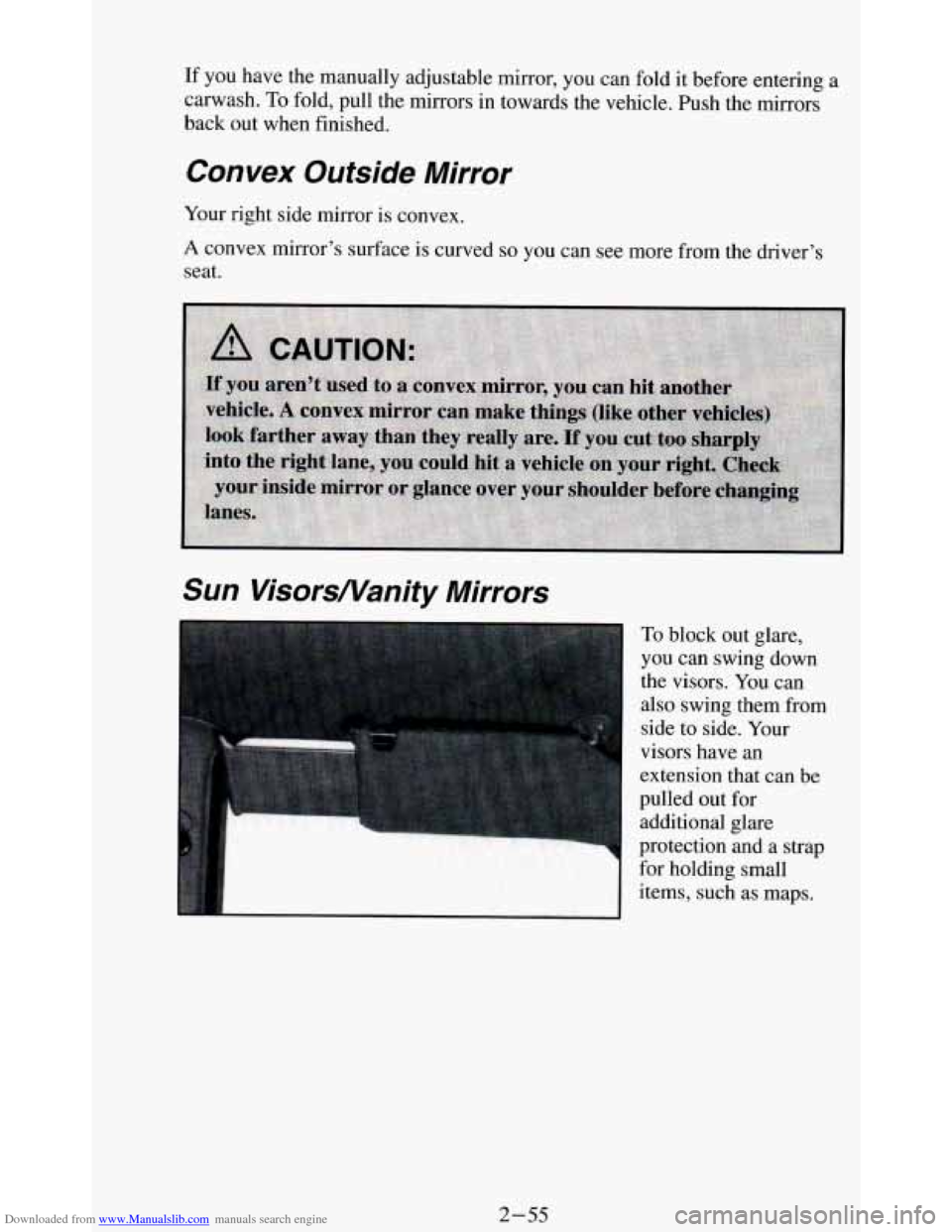
Downloaded from www.Manualslib.com manuals search engine If you have the manually adjustable mirror, you can fold it before entering a
carwash.
To fold, pull the mirrors in towards the vehicle. Push the mirrors
back out when finished.
Convex Outside Mirror
Your right side mirror is convex.
A convex mirror’s surface is curved so you can see more from the driver’s
seat.
Sun VisorsNanity Mirrors
To block out glare,
you can swing down
the visors. You can
also swing them from
side to side. Your
visors have an
extension that can be
pulled out
for
additional glare
protection and a strap for holding small
items, such as maps.
2-55
Page 110 of 348
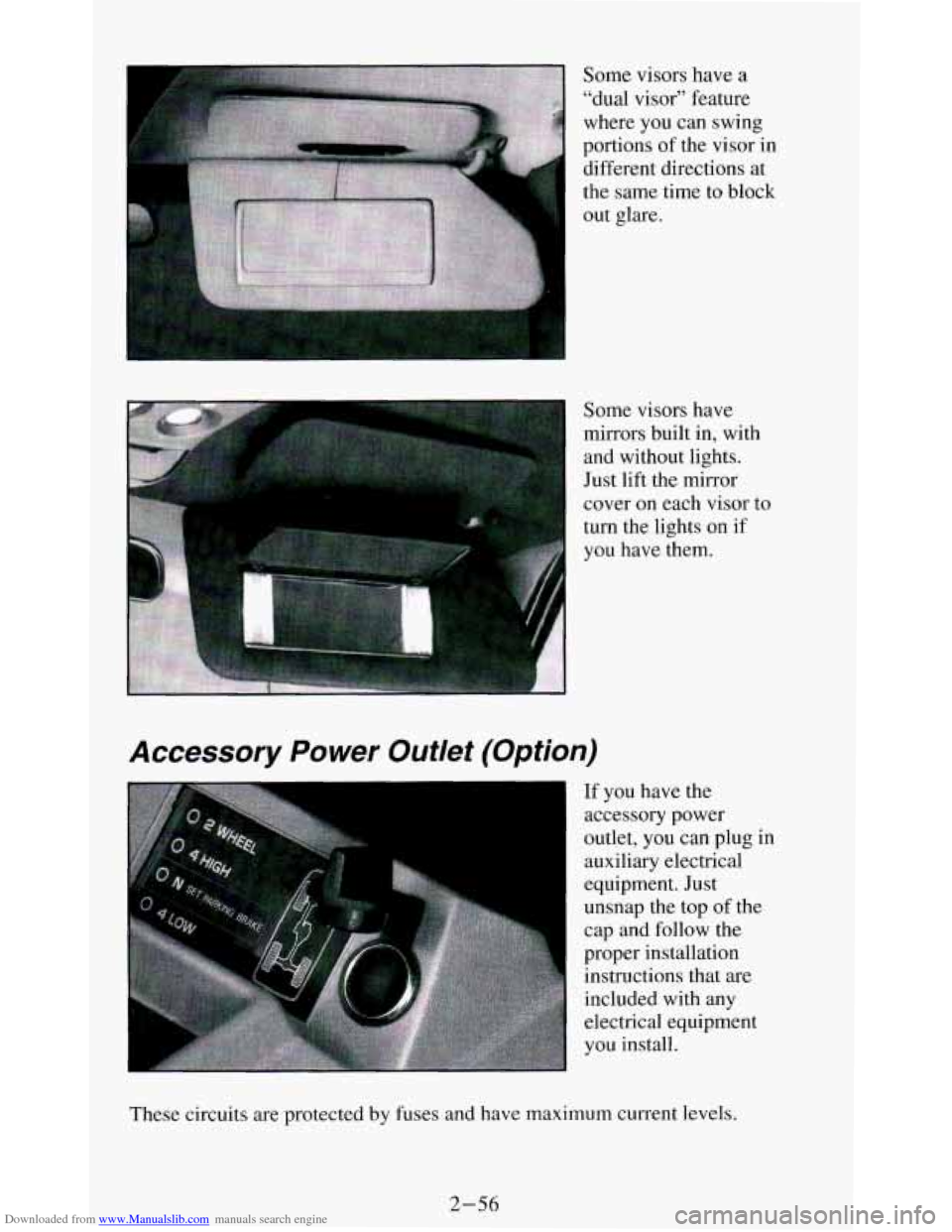
Downloaded from www.Manualslib.com manuals search engine Some visors have a
"dual visor" feature
where you can swing
portions of the visor in
different directions at
the same time to block
out glare.
Some visors have
mirrors built in, with and without lights.
Just lift the mirror
cover on each visor to
turn the lights on if
you have them.
Accessory Power Outlet (Option)
I If you have the
accessory power
outlet, you can plug in
auxiliary electrical
equipment. Just
unsnap the top of the
cap and follow the
proper installation instructions that are
included with any electrical equipment
you install.
These circuits are protected by fuses and have maximum current levels.
2-56
Page 119 of 348
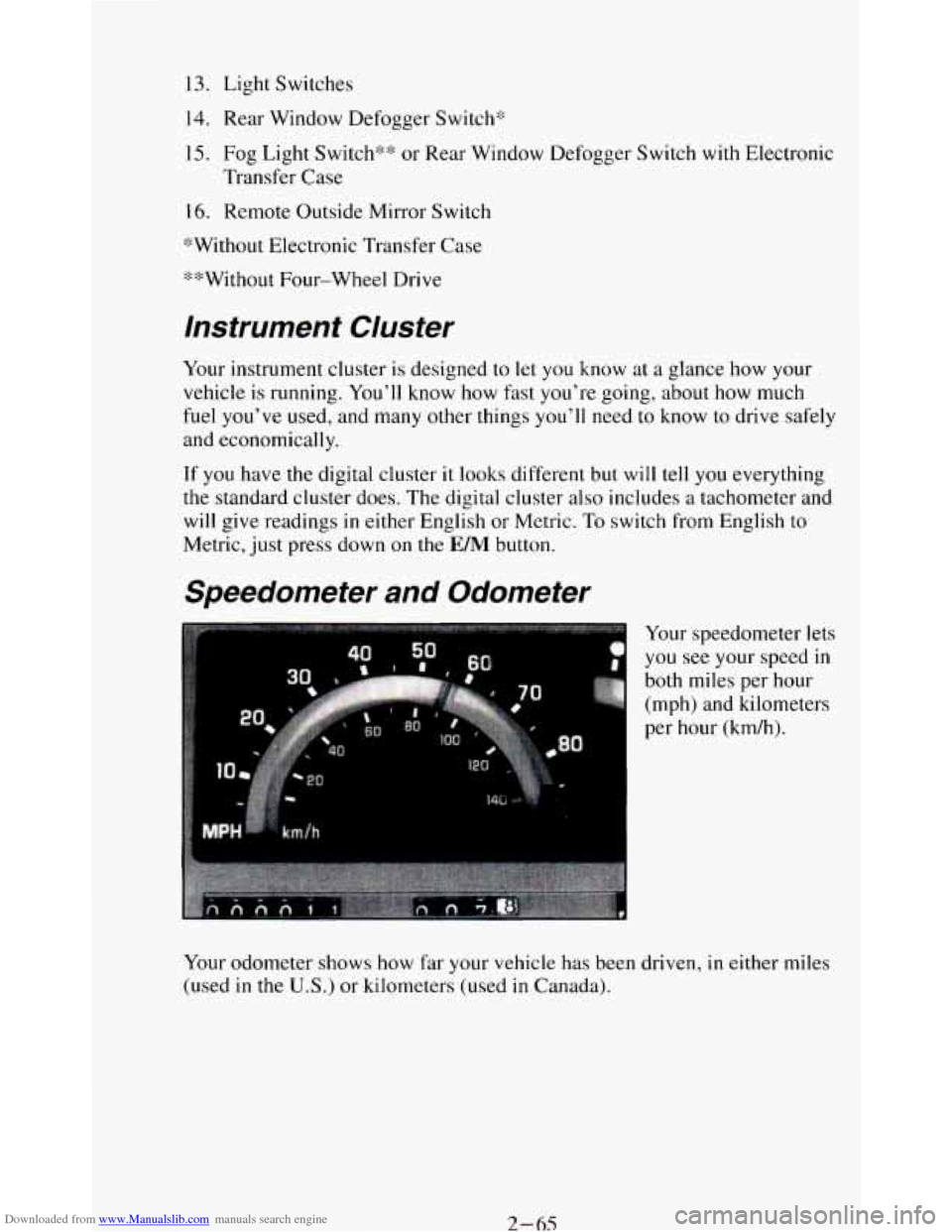
Downloaded from www.Manualslib.com manuals search engine 13. Light Switches
14. Rear Window Defogger Switch*
15. Fog Light Switch** or Rear Window Defogger Switch with Electronic
16. Remote Outside Mirror Switch
*Without Electronic Transfer Case
“*Without Four-wheel Drive
Transfer
Case
Instrument Cluster
Your instrument cluster is designed to let you know at a glance how your
vehicle is running. You’ll know how
fast you’re going, about how much
fuel you’ve used, and many other things
you’ll need to know to drive safely
and economically.
If you have the digital cluster it looks different but will tell you everything
the standard cluster does. The digital cluster
also includes a tachometer and
will give readings
in either English or Metric. To switch from English to
Metric, just press down on the E/M button.
Speedometer and Odometer
#3
Your speedometer lets
you see your speed
in
both miles per hour
(mph) and kilometers
per hour (kdh).
Y
Your odometer shows how far your vehicle has been driven, in either miles
(used in the
U.S.) or kilometers (used in Canada).
2-65
Page 169 of 348
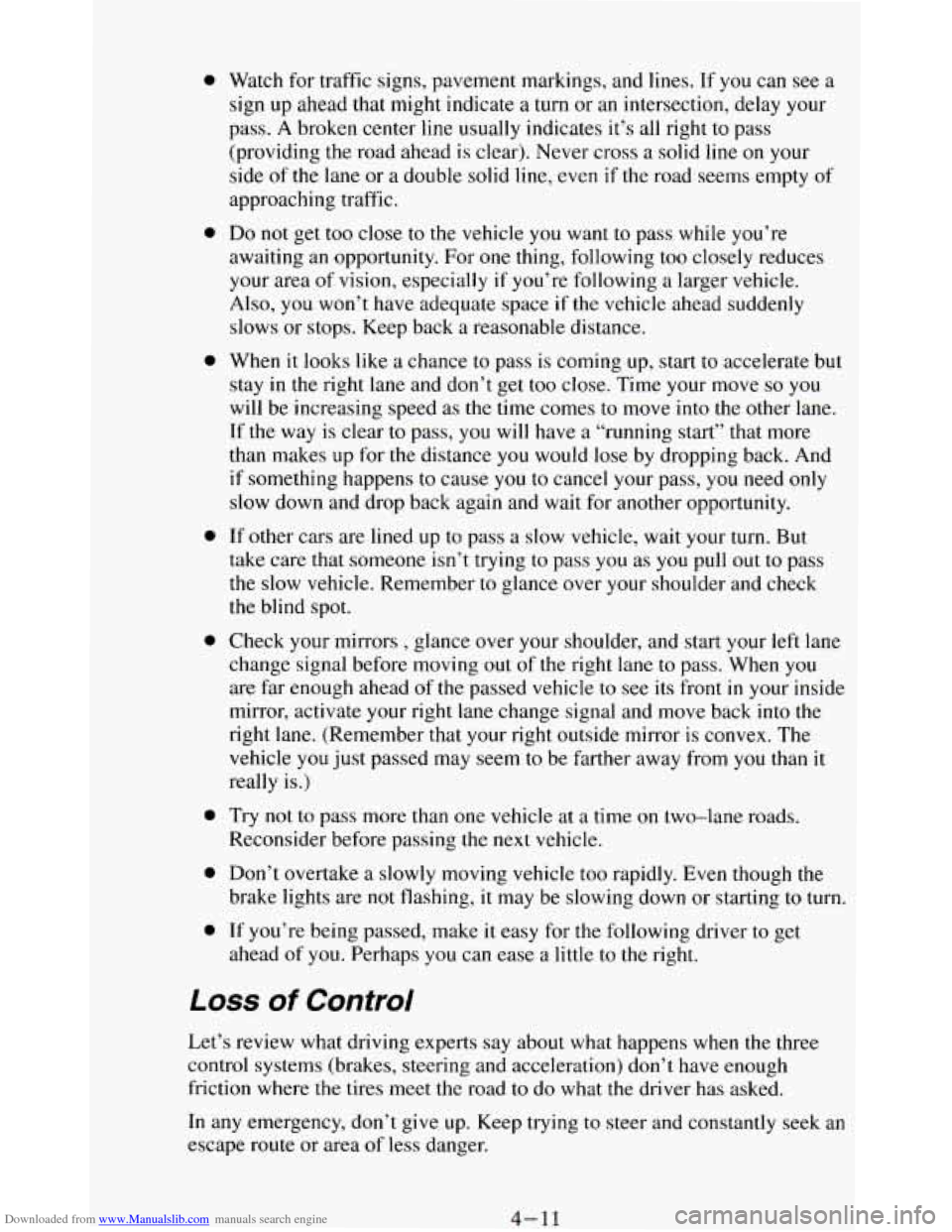
Downloaded from www.Manualslib.com manuals search engine 0
0
0
0
0
0
0
0
Watch for traffic signs, pavement markings, and lines. If you can see a
sign up ahead
that might indicate a turn or an intersection, delay your
pass.
A broken center line usually indicates it’s all right to pass
(providing the road ahead is clear). Never cross a solid line
on your
side
of the lane or a double solid line, even if the road seems empty of
approaching traffic.
Do not get too close to the vehicle you want to pass while you’re
awaiting an opportunity. For one thing, following too closely reduces
your area
of vision, especially if you’re following a larger vehicle.
Also,
you won’t have adequate space if the vehicle ahead suddenly
slows or stops. Keep back a reasonable distance.
When
it looks like a chance to pass is coming up, start to accelerate but
stay
in the right lane and don’t get too close. Time your move so you
will be increasing speed as the time comes to move into the other lane.
If the way is clear to pass,
you will have a “running start” that more
than makes up for
the distance you would lose by dropping back. And
if something happens to cause you to cancel your pass, you need only
slow down and drop back again and wait for another opportunity.
If other cars are lined up to pass a slow vehicle, wait your turn. But
take care that someone isn’t trying to pass you as
you pull out to pass
the slow vehicle. Remember
to glance over your shoulder and check
the blind spot.
Check your mirrors
, glance over your shoulder, and start your left lane
change signal before moving out of the right lane to pass. When
you
are far enough ahead of the passed vehicle to see its front in your inside
mirror, activate your right lane change signal and move back
into the
right lane. (Remember that your right outside mirror is convex. The
vehicle
you just passed may seem to be farther away from you than it
really is.)
Try
not to pass more than one vehicle at a time on two-lane roads.
Reconsider before passing the next vehicle.
Don’t overtake a
slowly moving vehicle too rapidly. Even though the
brake lights are not flashing,
it may be slowing down or starting to turn.
If you’re being passed, make it easy for the following driver to get
ahead
of you. Perhaps you can ease a little to the right.
Loss of Control
Let’s review what driving experts say about what happens when the three
control systems (brakes, steering and acceleration) don’t have enough
friction where the tires meet the road to do what the driver has asked.
In any emergency, don’t give up. Keep trying to steer and constantly seek an
escape route or area of less danger.
4- 11
Page 170 of 348
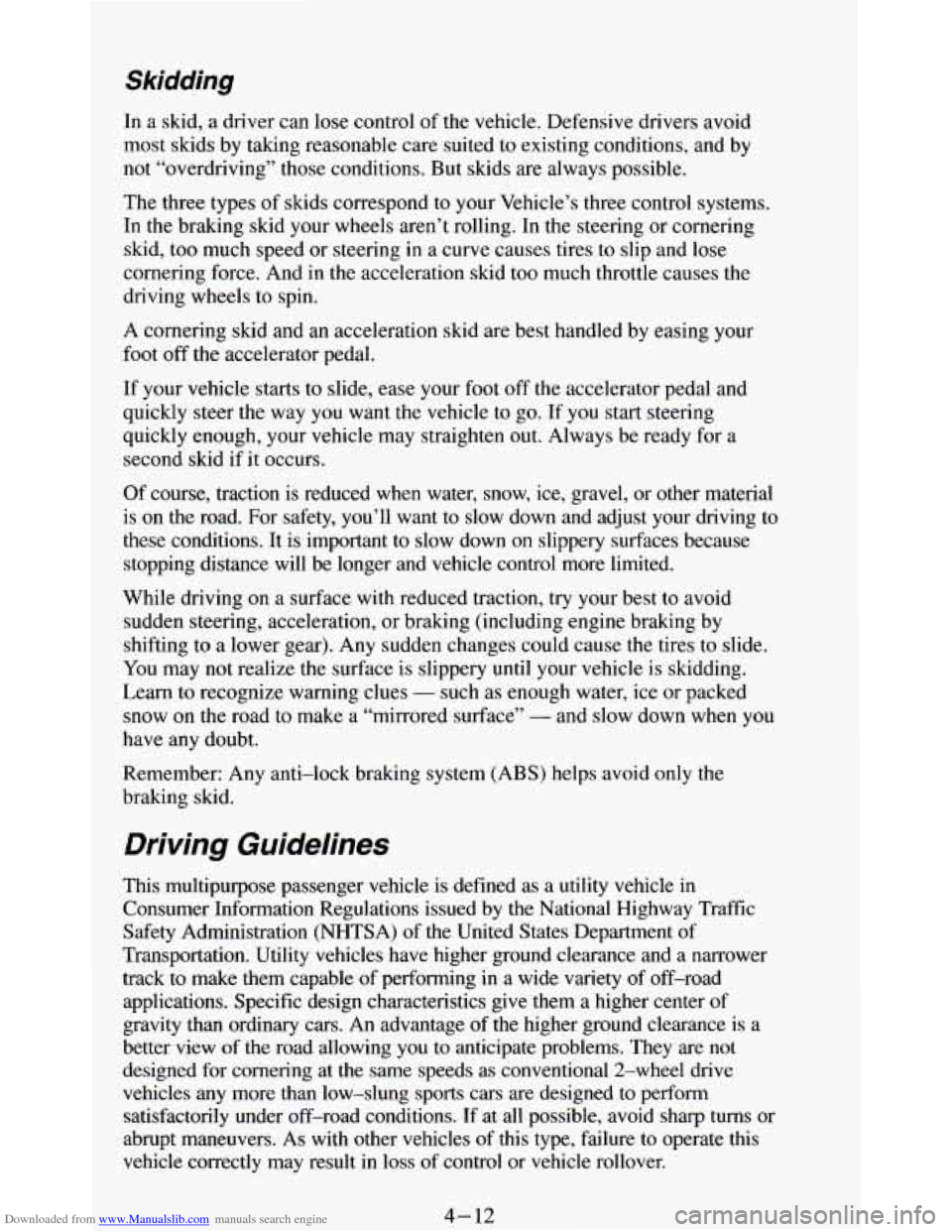
Downloaded from www.Manualslib.com manuals search engine Skidding
In a skid, a driver can lose control of the vehicle. Defensive drivers avoid
most skids by taking reasonable care suited to existing conditions, and
by
not “overdriving” those conditions. But skids are always possible.
The three types of skids correspond
to your Vehicle’s three control systems.
In the braking skid your wheels aren’t rolling.
In the steering or cornering
skid, too much speed or steering
in a curve causes tires to slip and lose
cornering force. And in the acceleration skid too much throttle causes the
driving wheels
to spin.
A cornering skid and an acceleration skid are best handled by easing your
foot off the accelerator pedal.
If your vehicle starts to slide, ease your foot off the accelerator pedal and
quickly steer the way you want
the vehicle to go. If you start steering
quickly enough, your vehicle may straighten out. Always be ready for a
second skid
if it occurs.
Of course, traction is reduced when water, snow, ice, gravel, or other material
is on the road. For safety, you’ll want to slow down and adjust your driving to
these conditions. It is important to slow down on slippery surfaces because
stopping distance will be longer and vehicle control more limited.
While driving on a surface
with reduced traction, try your best to avoid
sudden steering, acceleration, or braking (including engine braking by
shifting to a lower gear). Any sudden changes could cause the tires to slide.
You may not realize the surface is slippery until your vehicle is skidding.
Learn to recognize warning clues
- such as enough water, ice or packed
snow on the road to make a “mirrored surface” - and slow down when you
have any doubt.
Remember: Any anti-lock braking system (ABS) helps avoid only the
braking skid.
Driving Guidelines
This multipurpose passenger vehicle is defined as a utility vehicle in
Consumer Information Regulations issued by the National Highway Traffic
Safety Administration (NHTSA) of the United States Department of
Transportation. Utility vehicles have higher ground clearance and a narrower
track to make them capable of performing
in a wide variety of off-road
applications. Specific design characteristics give them a higher center of
gravity than ordinary cars.
An advantage of the higher ground clearance is a
better view of the road allowing you to anticipate problems. They are not
designed for cornering at the same speeds as conventional 2-wheel drive
vehicles any more than low-slung sports cars are designed to perform
satisfactorily under off-road conditions. If at
all possible, avoid sharp turns or
abrupt maneuvers.
As with other vehicles of this type, failure to operate this
vehicle correctly may result
in loss of control or vehicle rollover.
4-12